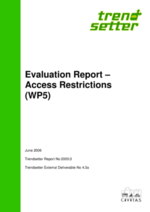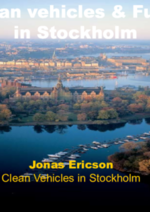TRENDSETTER
The five cities in TRENDSETTER — Graz (Austria), Lille (France), Pecs (Hungary), Prague (Czech Republic) and Stockholm (Sweden) — worked to improve urban air quality and reduce noise levels and congestion, while supporting sustainable mobility and improving quality of life.
About the project
By establishing examples of good practice, the five participating cities were able to show other cities the way towards sustainable mobility solutions.
In the framework of TRENDSETTER, 52 specific measures were implemented in different thematic areas. The complementary, mutually reinforcing measures focused on advanced mobility management schemes and clean vehicle fleets.
The project also promoted the use of public transportation and other alternatives to the private car and illustrated new approaches to improve logistics and the efficiency of goods distribution. In addition, TRENDSETTER increased public acceptance of bio-fuels and encouraged operators, politicians and social groups to use innovative, low-noise and low-emission technologies.
TRENDSETTER’s overall strategy was to achieve both short-term energy and emissions reductions and long-term shifts to greater use of public transportation and efficient urban goods flows. The project focused both on heavy vehicles (buses, lorries and vans) and private cars. The project included eight work packages in two major fields:
- better transport mobility management; and
- fleets of clean, cost-effective and energy-efficient vehicles.
These two major fields each covered public, commercial and private transportation. TRENDSETTER built on a mix of policy-based measures and technologies that combined the following activities:
- stimulating the use of public transportation through packages of measures that included new pricing strategies, bus priority systems, innovative information technologies, improved intermodal interchanges and transport demand systems;
- improving efficiency in urban freight transportation through logistics and information provision;
- achieving a higher market penetration for cleaner buses, lorries, vans and cars operating on renewable fuels by coordinated procurement to reduce prices, improved infrastructure;
- promoting alternatives to the private car through innovative services; and
- encouraging policy changes towards more sustainable urban transport systems.
Implementing sustainable mobility
Stockholm’s environmental zone was enlarged and other cities were provided with best practice strategies to develop environmental zones; decrease emissions, noise and energy consumption; and increase acceptance of clean vehicles.
In Prague, access restriction zones for heavy vehicles of over 6 tonnes were enlarged and optimised. As a result, the emissions and noise decreased in the city, the energy consumption was reduced due to a shift of vehicle fleets towards cleaner and more efficient vehicles. Besides reducing emissions, noise and energy consumption, the expansion of access restriction zones contributed to making the city centre more attractive.
Four pedestrian zones were established in central Graz, improving quality of life in the city. Sustainable alternatives to the private car were promoted, including walking and cycling, and other cities were provided with best practice examples. This measure was complemented by an extensive marketing campaign.
A new car-free zone was established in Pecs, and the existing pedestrian area was extended. Plans for a bicycle route in the city centre were also prepared. These activities led to a reduction in the volume of traffic in the historical city centre, thereby reducing air pollution and noise.
A second measure implemented in Pecs focused on obtaining information about existing traffic conditions and the status of public transportation in the city centre. Based on this information, a new integrated strategy was prepared, covering parking management, traffic planning and the development of the public transportation system.
The city of Stockholm was helped to prepare its congestion-charging scheme and to demonstrate its potential to reduce the volume of traffic on the most frequented roads during peak hours.
Besides reducing congestion and increasing accessibility, the measure promoted the use of public transportation and provided other cities with best practice strategies. Research and studies were carried out on the design of the congestion charge zone and possible technical systems.
Project results
One of the TRENDSETTER outputs was a series of studies about the environmental and socioeconomic effects of introducing new transport technologies and management solutions. The studies focused on both the short-term local effects of the TRENDSETTER project and on the potential exploitation of technical and policy measures across Europe.
In terms of quantitative results, the reduction in emissions of carbon dioxide was calculated as approximately 57,000 tonnes a year as a result of the project. The reduction in emissions of nitrogen oxide was calculated as 315 tonnes a year.
In terms of indirect effects, the actual reduction is likely to be far bigger, at around 900 tonnes a year. The reduction in emissions of particulate matter was calculated at 50 tonnes a year, and energy savings in TRENDSETTER cities totalled over 250 TJ a year.
Cities
Fast Facts
January 2006
February 2002
19 partners
Project partners
€35,686,495
Project funding
51 measures
Measures implemented



















